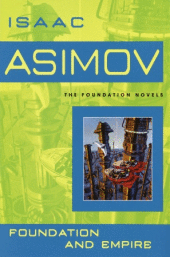 Asimov’s Foundation and Empire continues the underlying theme this year of meat and potatoes science fiction. The tale, or tales, still hold up surprisingly well. The first major one, detailing The Foundation’s encounter with an upwardly mobile general of the Empire, now reads like a short story developed after Asimov had an introduction to game theory. The Hand of Seldon reaches out and saves The Foundation, completely independent of the actions of the main players.
Asimov’s Foundation and Empire continues the underlying theme this year of meat and potatoes science fiction. The tale, or tales, still hold up surprisingly well. The first major one, detailing The Foundation’s encounter with an upwardly mobile general of the Empire, now reads like a short story developed after Asimov had an introduction to game theory. The Hand of Seldon reaches out and saves The Foundation, completely independent of the actions of the main players.
The heart of the book though, is the extensive tale of The Mule’s potential to absolutely disrupt Seldon’s plans for The Foundation. The Mule is a completely random wildcard. An unknown mutant of unknown powers who is rapidly conquering large portions of the galaxy’s fringe. His emergence coincides with a slow stagnation and corruption of The Foundation and the development of an opposing underground resistance.
Even knowing the rough eventual outcome of the story (I’ve read Foundation and Empire before, over a decade ago) the battle to defeat The Mule was deeply engrossing. Surprisingly so since the book crescendoes in a classic surprise ending built on a “hide in plain sight” gambit. This is an example of good storytelling being compelling even if you know the ending.
In retrospect, the two stories of Foundation and Empire are nice counterweights. The first story buttresses the concept of Seldon’s macro scale psychohistory being some sort of sufficiently advanced technology unto itself that it can transcend mere mortals. The Mule, and his eventual nemesis, points out that random events on the micro scale can have huge impacts, and that the irrationalities of humans (emotion, loyalty, intuition) still have something to say about our future.